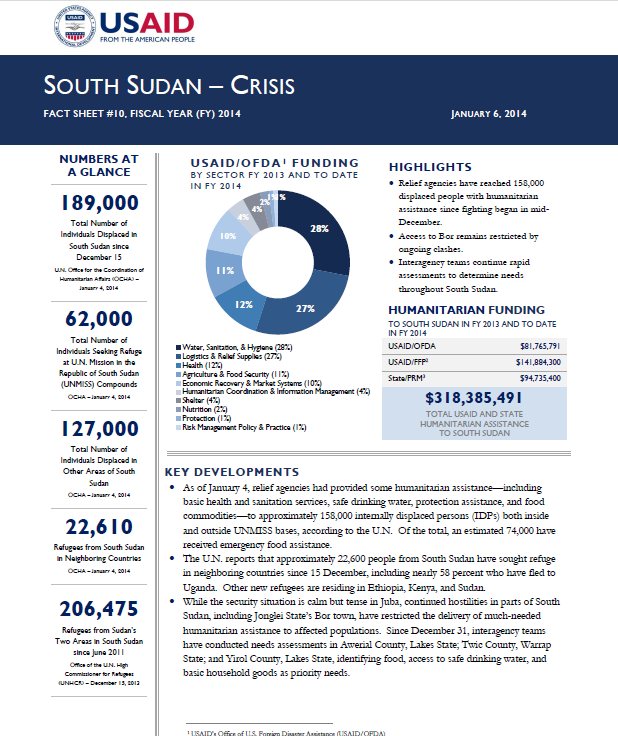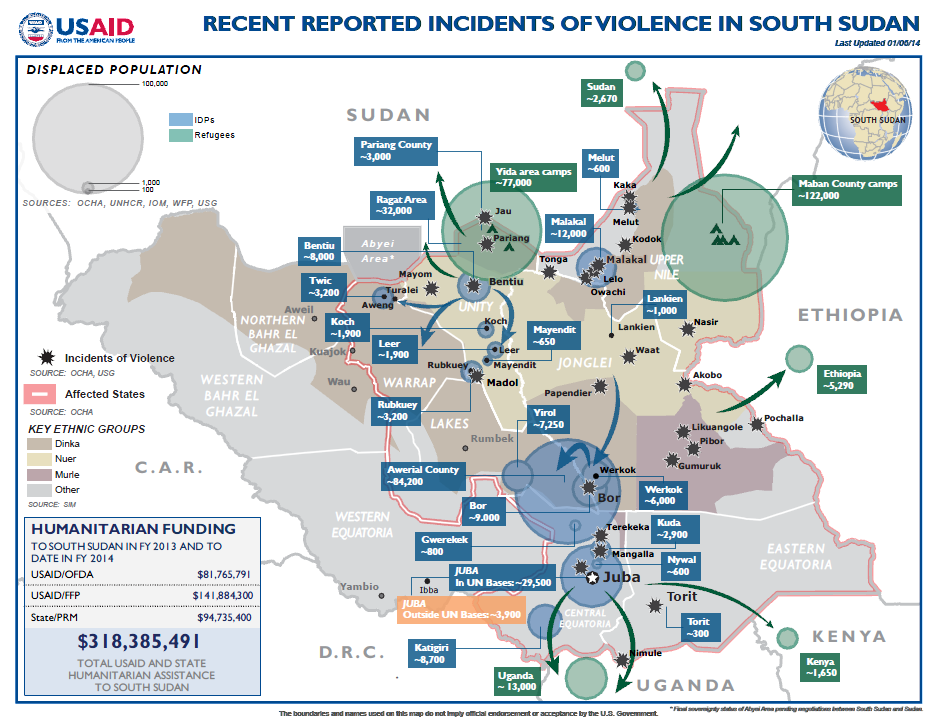- What We Do
- Agriculture and Food Security
- Democracy, Human Rights and Governance
- Economic Growth and Trade
- Education
- Ending Extreme Poverty
- Environment and Global Climate Change
- Gender Equality and Women's Empowerment
- Global Health
- Water and Sanitation
- Working in Crises and Conflict
- Disaster Assistance
- Political Transition Initiatives
- Conflict Mitigation and Prevention
- Countering Violent Extremism
- Disaster Risk Reduction
- Peacebuilding and Reconciliation
- Providing Safe & Secure Environments for Development
- Recovering From Crisis
- Resilience
- Tech Challenge for Atrocity Prevention
- World Humanitarian Day
- U.S. Global Development Lab
January 7, 2013
Numbers At A Glance
189,000
62,000
127,000
31,500
229,587
Humanitarian Funding:
To South Sudan To Date In FY2013 and FY2014:

| USAID/OFDA | $81,765,791 |
| USAID/FFP | $141,884,300 |
| State/PRMDoD | $94,735,400 |
| TOTAL | $318,385,491 |
Highlights
Violence has displaced approximately 31,500 South Sudanese to neighboring countries since December 15.
Access to Bor town, Jonglei State, remains restricted as significant humanitarian needs persist.
Relief agencies continue efforts to reach conflict-affected populations throughout South Sudan.
KEY DEVELOPMENTS
Countries neighboring South Sudan have received an increasing number of South Sudanese refugees in recent days as violence that broke out on December 15 continues to result in widespread insecurity. As of January 6, agencies had registered 31,500 refugees in Uganda, Ethiopia, and Kenya, with an unconfirmed number of refugees arriving in Sudan.
While negotiations in Addis Ababa, Ethiopia, between opposition and Government of the Republic of South Sudan (RSS) officials remain ongoing, the security situation in South Sudan remains fluid. Media reports indicate that Sudan People’s Liberation Army (SPLA) forces are preparing to retake Bor town, Jonglei State, where insecurity has significantly impeded humanitarian access in recent days.
Despite ongoing fighting, humanitarian agencies—including U.S. Government (USG) partners—are reaching some conflict-affected populations with humanitarian assistance, as security, access, and staffing allow. As of January 4, relief partners had provided humanitarian assistance to an estimated 158,000 conflict-affected individuals, although not all of that population is receiving aid on a consistent basis.
SITUATION AND DISPLACEMENT UPDATE
The security situation remains fluid in South Sudan, with hostilities continuing in many areas of the country. The U.N. highlights concern regarding the security situation in the opposition-held Bor town, Jonglei, following a series of clashes south of Bor town in recent days and the anticipation of additional violence. Continued insecurity has led to the need for increased medical support, as well as the need to resupply food and overall emergency relief commodity stocks. Approximately 9,000 individuals are sheltering at the UNMISS base in Bor.
Amidst an unpredictable security situation in Juba, additional people sought shelter at the two UNMISS compounds—Tong Ping and U.N. House 3—in recent days. The U.N. reports an additional 1,000 individuals sought shelter at the U.N. House 3 compound, where the International Organization for Migration (IOM) had registered more than 6,600 individuals as of January 5, with registration efforts ongoing. IOM recently completed registration of 17,400 individuals at Tong Ping base. IOM reports that the Tong Ping base had already exceeded capacity prior to the new arrivals, with protection a critical concern due to reports of violence in the vicinity and strained resources at the site.
In addition to the estimated 189,000 internally displaced persons (IDPs) displaced by violence since December 15, populations continue to cross into neighboring countries. As of January 7, approximately 23,000 South Sudanese refugees had arrived in Uganda, approximately 5,300 in Ethiopia, nearly 3,200 in Kenya, and an unconfirmed number in Sudan, according to UNHCR. Population outflows have increased in recent days, with up to 2,500 people arriving in Uganda and 300 in Kenya’s Kakuma Refugee Camp daily.
The U.N. deployed three helicopters to Juba on January 6 to support security and relief activities, as part of an overall effort to enhance UNMISS presence and response capacity in South Sudan.
South Sudan Crisis Fact Sheeet #11 January 7, 2014 ![]() (pdf - 359k)
(pdf - 359k)
HUMANITARIAN NEEDS AND RESPONSE
Humanitarian agencies—including USG partners—are addressing humanitarian needs in conflict-affected areas of South Sudan. As of January 4, relief agencies had provided assistance to approximately 158,000 people. The U.N. reports that additional humanitarian needs persist among affected populations, even among those reached with some form of assistance.
On January 6, a flight transporting UNHCR commodities—including 12,500 blankets, 2,500 kitchen sets, and 4,000 plastic sheets—arrived in Juba. UNHCR, a State/PRM partner, will distribute the commodities to populations sheltering in and around Juba. A Save the Children relief commodity flight also recently arrived in Juba, transporting shelter materials, blankets, and mosquito nets for distribution to more than 5,000 families in Juba and Awerial County, Lakes State.
USAID/FFP partner the U.N. World Food Program (WFP) has distributed food commodities to nearly 74,000 people affected by the current hostilities across South Sudan—including approximately 32,000 people in Juba; 8,200 in Bentiu; 7,500 in Minkamman, Lakes State; 3,500 in Mabior, Jonglei State; and more than 22,000 in Malakal, Upper Nile State.
South Sudan Crisis Map #11 January 7, 2014 ![]() (pdf - 420k)
(pdf - 420k)
Since December 16, USAID/OFDA has approved or redirected six rapid response fund (RRF) sub-grants to national and international non-governmental organizations (NGOs) in South Sudan to respond to effects of the ongoing fighting. The RRF is a $6 million flexible IOM-managed fund that enables quick and agile responses to disasters. With USAID/OFDA funding, three national and two international NGOs are responding to immediate protection, relief supply, and water, sanitation, and hygiene (WASH) needs in Juba’s UNMISS compounds. An additional NGO also continues to provide WASH support in Awerial County, Lakes State, including the construction of 1,000 latrine stances, 400 bathing shelters, and training of 60 hygiene promoters.
Humanitarian agencies are also enhancing efforts to provide medical assistance. Médecins Sans Frontières teams are providing medical assistance to more than 110,000 conflict-affected individuals in Juba, Central Equatoria State; Awerial, Lakes State; and Malakal, Upper Nile State.
2013 TOTAL HUMANITARIAN FUNDING*

*Funding figures are as of January 7, 2014. All international figures are according to OCHA’s Financial Tracking Service and based on international commitments during the 2013 calendar year, while USG figures are according to the USG and reflect the most recent USG commitments based on the 2013 fiscal year, which began on October 1, 2012, and ended September 30, 2013, as well as the 2014 fiscal year, which began on October 1, 2013.









Comment
Make a general inquiry or suggest an improvement.